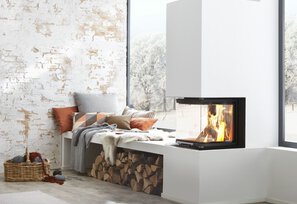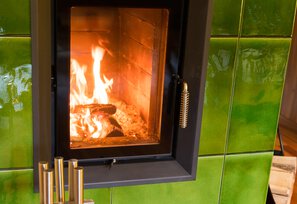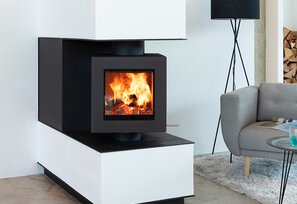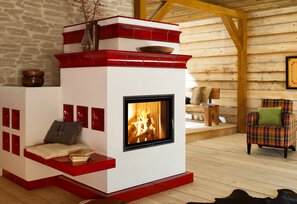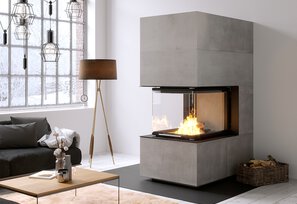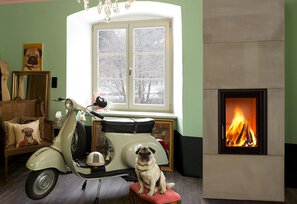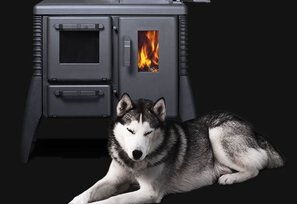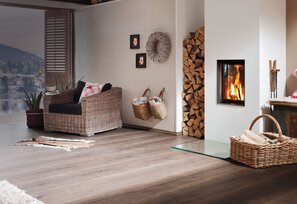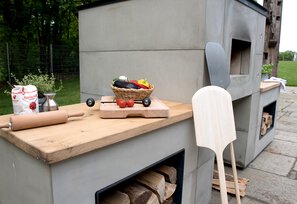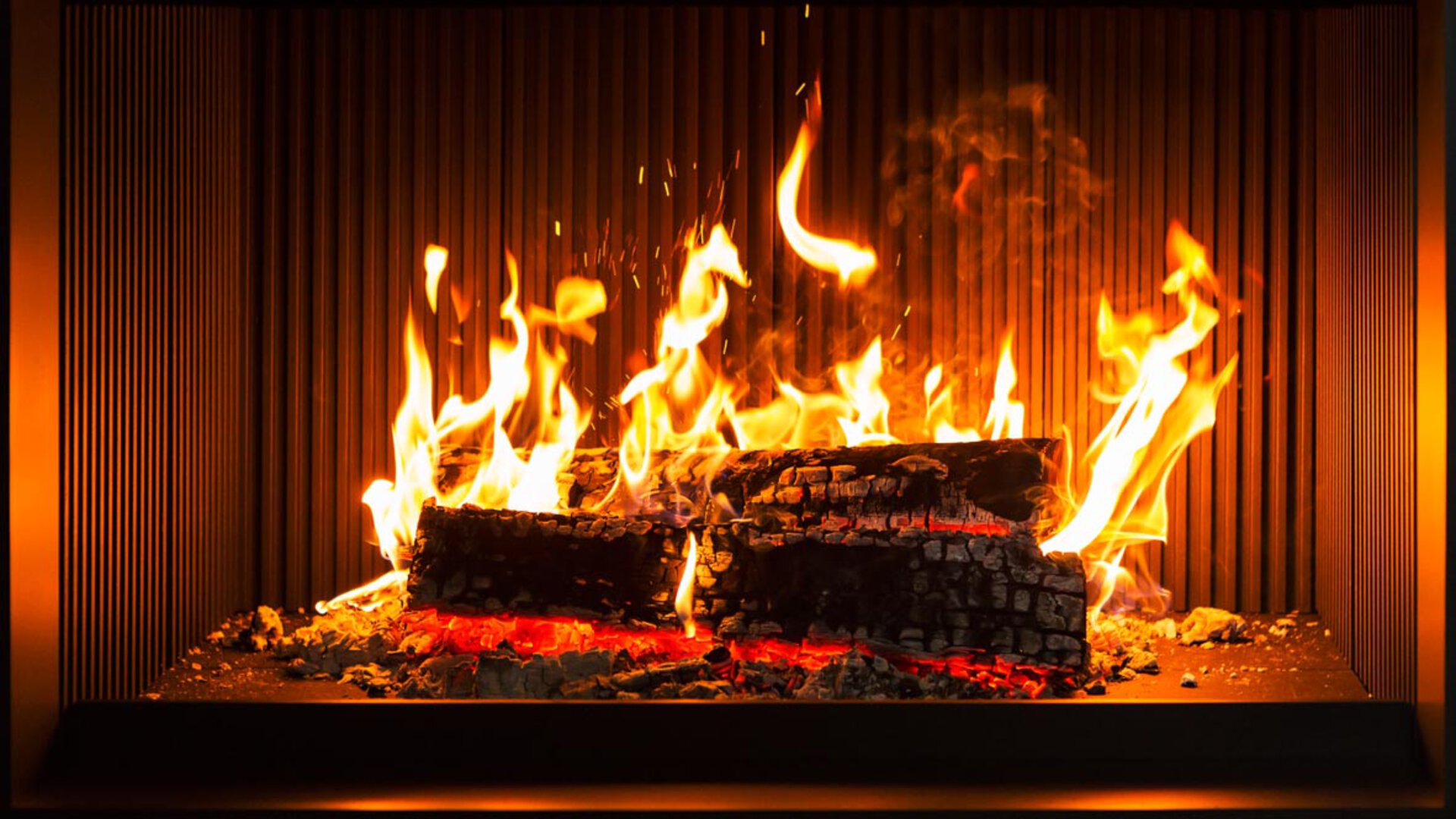Tiled stove
Fire atmosphere with heat storage
The classic wood stove with individual stove cover
As in grandma's times, a tiled stove often still is the centre of a house where everyone likes to get together. The cosy warmth can be enjoyed particularly well on the stove bench or a seating niche. A tiled stove is a wood fire insert. In the old days, it was intended to heat an entire house or several rooms while cooking on the tiled cooker. Because of the generous storage, tiled stoves can absorb the heat produced during burn-off and then release it over a long period of time. This is why a tiled stove, in contrast to a fireplace, is also called a storage heater. The oldest version of a tiled stove is the masonry heater or custom tiled stove.
For primarily heat
Comforting radiant heat
There are different types of heat produced by heating devices such as a stove, a fireplace or a tiled stove. The so-called radiant heat is produced by the storage heater. It is emitted via long-wave radiation to objects in the room, which are heated in this way. Radiant heat does not heat the air, but solid bodies. Its effect is similar to that of the sun, which is also the reason why people find radiant heat particularly pleasant. The humidity in the room is not affected and no dust is stirred up, as is the case with convection heat. Here, the heat is transported through the air. Although this happens very quickly, which is an advantage over radiant heat, there is often an unpleasant feeling of draught. In addition, convection heat causes a temperature gradient in the room: the hot air rises to the top, the cold air settles at the bottom. And: Due to the air circulation, house dust is distributed in the room where the device is installed, which is not only a problem for allergy sufferers.
Tiled stove HKD
Wood fire stove system with large viewing window
The HKD series thus combines atmosphere and long-lasting, healthy heat. For the craftsman furnace builder, it offers heating inserts in different filling loads and glass formats, depending on your wishes and requirements. The size and the format give a tiled stove its special look:
- Corner and cross formats can be harmoniously matched to the architecture and the room layout as modern stove furniture.
- Also possible are tall formats for tiled stoves with a fireplace look, the viewing glass can be flat or round.
- Standard formats for the traditional tiled stove heated from the hallway or adjoining room offer a small inspection window in the cast-iron door.
Tiled stove inserts that have doors on both the front and back are called tunnel stoves, tunnel or see-through units. This design, with two viewing glass faces of the same size, is often installed in stoves that function as room dividers.
Naturally, there are different applications and wishes that a wood fire stove system should fulfil. Constructively as well as visually, the individual heating inserts therefore differ in filling load and glass format. For example, there are stoves in which the fire is operated with smaller quantities of wood in a fireplace look or combustion chambers with large filling loads for heating up ceramic storage. But all HKD devices have one thing in common: They are durable, easy to operate and their combustion is clean.
The story of the fireplace and tiled stove
Or how the BRUNNER HKD came to be
Fire in an open fireplace is something very beautiful, but also quite unreasonable. The precious heat contained in the fire is not released into the living area, but disappears for the most part in the chimney. From a classic tiled stove, the usable amount of heat is optimally released to the surroundings, but the flame picture is nowhere to be seen or only through a small glass door.
To combine both advantages without major disadvantages - that would be ingenious. This idea was already implemented by BRUNNER in 1991. The result: a new generation of heating inserts with a large glass door instead of the usual cast front with a small fire door.
With the HKD series, it has been possible for the first time to combine the beauty of the visible fireplace with the heating output of a tiled stove heating insert. This is made possible by a special combustion chamber geometry that burns the wood in an environment-friendly way and at high temperatures. However, the hot flue gases do not immediately go into the chimney from there, but flow across a reheating surface. The heat-giving energy of the heating gases is absorbed by this reheating surface and released into the room via the stove cover. This special feature achieves the high efficiency. The craftsmanship of the reheating surface and the stove casing determines how efficiently the heat is emitted.
Hood versions
Stove height as desired
In most cases, the reheating surface for the passage of the heating gases is installed alongside. Cast iron domes are used for this application. For stoves with a low overall height, the low cast iron domes are used (e.g. room dividers with tunnel versions). The version with attached storage rings is used when a lateral reheating surface is not possible from the space available. The hood versions can be realised with almost all HKD designs (exceptions: HKD 2.2k, HKD 6.1).
Craft-made storage
The craft-made storage represents the most original form. Right-angled heating gas channels, which form the ceramic draught system, are made from fireclay plates by individual cutting. This extracts the heat from the heating gases, stores it and releases it again across the tiled stove surface.
Modular storage systems
Ceramic modular storage bricks are being used more and more. The advantages of the prefabricated storage elements are obvious: Precisely fitting shaped pieces enable a quick construction, their smooth-walled design and the constant round cross-section have the lowest flow resistances. The significantly higher bulk density than conventional fireclay slabs combines a unique heat absorption and conductivity on the smallest footprint.

The HKD series
Advantages of a tiled stove and a fireplace
Handcrafted tiled stoves are not comparable with cheap fireplace stoves. A tiled stove is first and foremost a heating device with mass, the flame pattern of the wood fire is either not visible at all or only through a small glass door. In contrast, a fireplace or a heating fireplace is primarily intended to convey the atmosphere of a fire and a visual experience. However, most of the precious heat disappears in the chimney.
With this in mind, the premium manufacturer BRUNNER from Lower Bavaria has developed wood fires that meet the demands for durability, high resistance, the highest requirements for efficiency and emission values. These achievements have been brought together in the HKD series, which combines the advantages of both fires: a heating insert with a large glass door instead of the usual cast-iron front with a small fire door. This is the first time that the beauty of a visible fireplace has been combined with the heating performance of a tiled stove insert, thanks to a special combustion chamber geometry. It makes it possible to burn the wood at high temperatures and in an environment-friendly way. The hot flue gases do not immediately go into the chimney, they first flow across a reheating surface which absorbs the energy of the heating gases and releases it into the room via the stove cover. This enables a high degree of efficiency. version.

Tiled stove heating
A tiled stove is a good investment - but only if it is operated correctly. This starts with the fuel. You should only use well-seasoned and dry wood, hardwood such as beech has particularly good heating properties. Damp wood draws a lot of heat from the burning process. Why a tiled stove smells bad when it is heated up almost always has something to do with incorrect handling. You should therefore pay attention to these things:
- For ignition, we recommend small pieces of wood or BRUNNER Fidibus, a pure natural product. Under no circumstances should you use newspaper.
- When lighting the stove for the first time, it is important that all air inlets are open. Only when the main combustion is almost over after 30 to 40 minutes, reduce the air supply. And when to close the tiled stove? Only in the glowing phase are the regulators closed completely.
- Loading wood on an ember that is just about to ignite is bad, as it can cause a smouldering fire that lasts for minutes and the required temperatures for combustion are not reached. If you throttle down your tiled stove too much, you also risk damaging the chimney.
- If too much wood is added to the combustion chamber, this can lead to an increased release of hydrocarbons.
Generally, the emission output increases many times over if heating is faulty, while at the same time the efficiency drops. With a combustion air control system such as the Electronic Combustion Control (EAS) from the premium manufacturer BRUNNER from Lower Bavaria, operating errors can be avoided. All that needs to be done is to fill the stove with wood, ignite it and add more, everything else runs automatically.


The secret of a clean viewing glass
Closed combustion air routing in the heating insert for outside air connection. The air inlets in the combustion chamber and the combustion chamber geometry have been optimised via simulations and test bench trials to ensure optimum afterburning. The geometry allows the glass to remain clean for an unusually long time when operated as intended.
Not visible but valuable
The combustion air supply via the corner glass and the combustion chamber geometry are designed and constructed in such a way that an even combustion pattern is achieved. The basis for minimising the typical soiling of the corner areas.
Easy to operate
Simple and uncomplicated
Manually operated or automated
The combustion air can be controlled manually with just one operating element (lever). Effortless and easy to understand. The symbols on the glass provide additional support.
Of course, the white display (EAS) shows that it can also be operated automatically. The most convenient version is the combination with an electronic combustion control (EAS). All you have to do is light the stove or add fuel, the control system takes care of everything else. High efficiency is the result, because the EAS servomotor never forgets to readjust and always stops the combustion air supply at the end of the burn-off. This is particularly convenient if the stove cannot be operated any further after its kindling, either because you go to bed or you leave the house.

The water-bearing tiled stove
You can also use the heating power of a tiled stove to support the central heating of a house, namely with a water-bearing tiled stove. There is a suitable water-bearing tiled stove for every house, every living and every heating situation. If the stove primarily serves as a support for the heating concept of the house, a "Stubenkessel" (parlour boiler) is the right one. Thanks to its large boiler output, it can be set to boiler operation, i.e. heating water, or to storage operation for radiant heat in the room, depending on requirements. Parlour boilers are available in various formats and with different combustion chamber sizes. In contrast to the parlour boiler, the principle of a compact boiler offers space-saving stove shapes with solid heating water. One can combine small storage and medium boiler output or large storage and smaller boiler output.
Who cleans the tiled stove?
If you want to enjoy your tiled stove for a long time, you should regularly have it professionally cleaned and maintained, preferably before the start of each heating season. This is because deposits occur in the stove itself as well as in the pipes and tiled stove flues, which must be removed. Soot deposits, for example, have an insulating effect that leads to reduced heat emission. The discharge of gases can also be impeded, which is a safety risk. Maintenance of a tiled stove also includes the replacement of wearing parts such as gaskets. Tiled stove cleaning and maintenance is carried out by specialist stove-building companies. The chimney sweep is responsible for cleaning and maintaining the chimney.
What does it cost to have the tiled stove cleaned?
By law, regular inspection, cleaning and maintenance of fireplaces by the district chimney sweep is mandatory. Maintenance of fireplaces by the district chimney sweep. As a rule, this is done two to three times a year. During this time, other components of the tiled stove can also be inspected and cleaned if necessary or desired. The chimney sweep needs about one hour for a tiled stove cleaning, the costs for which are on average about 100 euros.

Cleaning the tiled stove: this is what matters
What could be better than coming home on a winter's day, igniting the stove, making yourself comfortable in front of the flames and enjoying the warmth? To enjoy your tiled stove for a long time and for faultless operation, however, you should have it cleaned and serviced regularly.
How often: Clean the tiled stove?
While the chimney sweep takes care of the chimney and its cleaning, the cleaning of the wood stove is the responsibility of the stove owner himself. And this should be done at regular intervals, preferably before each heating season. Because combustion residues and soot deposit both in the tiled stove and in the stove pipe, impairing the function of the fireplace and preventing proper heating. If you notice this, it is time for a thorough cleaning:
- The performance becomes weaker, the tiled stove simply does not come up to temperature because combustion is incomplete.
- The fireplace slide is very sooty.
- The logs do not burn properly, they rather smoulder.
The pipe from the stove to the chimney, for the exit of all exhaust gases, is particularly stressed. If it is too dirty, the exhaust gases are less and less able to escape, the smoke increases and soot fire, also called chimney or flue fire, can even develop in the fireplace. It is high time to remove the dirt and clean both the pipe and the firebox or firebox. A full ash box and a lot of ash residue also hinder optimal combustion. Whether and how much ash may remain in the fireplace insert varies from fireplace to fireplace and can be found in the manufacturer's operating instructions.
How to clean the firebox and ash tray
When cleaning the firebox and ash tray, a fireplace tool is helpful. The poker is suitable for transferring ash residues into the ash tray. With many tiled stove models, the ash tray can be pulled out so that the ash can easily be poured into a fireproof metal bucket. It can be disposed of in the household waste, but only when it has cooled down completely and is cold. There are also special ash vacuum cleaners with an integrated ash filter; the tiled stove cannot be cleaned any cleaner than this. A normal hoover should only be used for the interior of the fireplace if it is also fitted with an ash filter designed for this purpose.
The ventilation slots can also be cleaned well with a hand brush, they are very important for the wood stove to function properly. Damp newspaper helps to get the stove glazing really clean. Simply dip it in white ash and then wipe the glass carefully, finishing with a little glass cleaner.
Instructions for cleaning a tiled stove
A little more time-consuming, but always necessary, is cleaning the stove pipe, which is the connecting piece between the wood stove and the chimney. It is removed from the top of the fireplace and the openings are best covered with a bag. This work is easier for two people. To prevent soot from soiling the floor or furniture during cleaning, it is advisable to cover them with a tarpaulin or sheet beforehand. It is also advisable to wear rubber gloves and a face mask to avoid inhaling soot particles. The dismantled flue pipe can then be thoroughly cleaned of all dirt outdoors with a poker or hand brush, not forgetting the stove spigot. The firebricks can be loosened according to the manufacturer's instructions and also thoroughly vacuumed. Then mount the pipe back again and the tiled stove is ready for use.
Potato peelings against dirt
On the outside, the tiles of the stove can easily be vacuumed with the brush attachment of the hoover. A cloth will also do the job. If the stove tiles are more heavily soiled, a tried and tested household remedy will help: burnt potato peelings, which have a cleaning power all of their own. Simply run a handful of burnt potato peelings over the tiles and the dirt disappears as easily as child's play. Afterwards, simply wipe the tiles with a clean, damp cloth and the tiled stove will shine like new.
If you want to change the exterior of a tiled stove, you can paint the stove tiles - but this does not replace normal maintenance and cleaning. The problem is the paints. Even if they are heat-resistant and suitable for heating elements, they only meet the requirements to which stove tiles are exposed to a limited extent. It is better to prime glazed stove tiles and plaster them with special mortar. The smooth surface can then be painted. When cleaning wood stoves with a soapstone facing, you can take the rough side of a dry, clean dishwashing sponge, rub the soapstone vigorously and wipe with a damp cloth. Soapstone is popular because it has good heat storage properties.
To clean the firebricks of the stove, it is advisable to use a spatula to carefully scrape off the soot deposits and then wipe with the scraped side of a damp sponge. Important: The firebricks must be completely dry before the tiled stove can be put back into operation.

Conclusion
Regular cleaning pays off
By cleaning the ceramic flues of your tiled stove regularly, or commissioning a tiled stove cleaning, you not only increase its service life, but also its efficiency. Soot deposits and other dirt are effectively removed. A fireplace set with a poker is definitely a good purchase for every stove owner who takes care of their stove. You can also resort to grandma's home remedies such as potato peelings; they make the stove's tiles shine. If the firebox, stove pipe and viewing glass are completely clean, the stove will heat like a new one. Nothing stands in the way of cosy hours in front of the crackling and warming fire.
When can I replace the tiled stove?
In order to prevent further increases in particulate matter and carbon monoxide pollution, the state has set new limits in their Federal Immission Control Ordinance (BImSchV). These limits may no longer be exceeded by combustion systems such as wood stoves, heating fireplaces and tiled stoves. Old installations from before 1985 already had to be shut down. Newer systems installed between 1985 and 2010 must be retrofitted if they cannot meet the limit values. There were or are two deadlines for this:
- A replacement by 31 December2020 was necessary for all plants that were put into operation between 1985 and 1994.
- All plants between 1995 and 2010 must be replaced by 31 December2024 at the latest.
The type and model of the stove, fireplace or wood fire insert can be read off the type plate, which in turn can be used to check on the HKI website http://www.cert.hki-online.de/ whether and when the tiled stove replacement or the renewal of the system is required. If necessary, the manufacturer can also provide information. With a new BRUNNER wood fire insert, the currently most demanding emission limit values of stage 2 are even undercut. In addition, wood consumption is reduced, which in turn saves costs.
Exempt from the obligation to retrofit or decommission are, for example, open fireplaces, custom masonry heaters or single-room combustion systems that are used exclusively to supply heat in residential units and single-room combustion systems that were manufactured before 1950. By the way, when we talk about replacing a tiled stove, we mean that only the heating insert is replaced, the stove itself remains the same. The process is simple and quick, often taking no more than a few hours. The craftsman only has to separate the existing tiled stove insert with the heating gas pipe from the reheating surface of the tiled stove and pull it out like a drawer. The new heating insert is pushed in on the same support bearing and the heating gas pipe is reconnected.
The right fuel
If you notice an unusually strong development of soot in your tiled stove and if the fireplace slides are very black, this could be due to the fuel, possibly the wood is not dry enough and still too moist. This can be easily checked with a measuring device. If the water content is more than 20 percent, the efficiency of the wood drops enormously. To ensure that the firewood is dry enough, it should be split into small logs and stored upright for about two years, well protected from the air. Dry, roofed and well-ventilated shelters are suitable for storing wood. You should also make sure that no moisture can rise from the ground. In addition, the firewood that is needed immediately can be stored next to the fireplace for a few days before heating. This way it will be tinder-dry and have the highest calorific value. Wood should not be stored in closed cellars or wrapped in foil. Beech logs are generally best for heating, they make the most heat, maple, cherry, ash or hornbeam are also good, but harder to split. Alder, poplar and willow are very soft and inherently leave a high ash layer, and softwood from pine or spruce has a large spark, which can be problematic, especially in open fireplaces. Paper must generally not be burnt in a tiled stove, not even for kindling.

How much does a masonry fireplace cost?
For a masonry fireplace that is planned and built individually and according to all the customer's wishes, costs of at least 10,000 euros must be expected. For the smaller purse and all those who nevertheless do not want to do without the pleasant atmosphere and warmth of a wood fire, there are cheaper alternatives, such as a wood stove. Which fireplace is better, be it a tiled stove, a custom stove or a wood stove, depends on the customer's requirements, needs and intended use, and on the conditions of the house. For this reason, a fireplace installation is often already taken into account when building a house. If you want to use a fireplace as a permanent heating system or even as the sole heating system, a masonry heater that provides a lot of radiant heat is a good choice. Wood only needs to be added after hours, otherwise a masonry heater heats almost independently. If you need heat quickly after work or on a cool autumn morning, you should choose a Swedish stove.
A tiled stove is a wood fire insert that in earlier times was intended to heat the whole house. In contrast to the fireplace, the tiled stove is a storage furnace. The heat energy produced by the burning of the wood is stored in a generously dimensioned mass and released into the living space. This is done by means of so-called radiant heat, which does not heat the surrounding air but physical objects, such as people. Although the name suggests that a tiled stove is a stove with tiles, i.e. ceramics, nowadays a large number of tiled stoves are installed with other materials such as plaster, brick or metal.
Although it may not appear so, different wood heaters produce different types of heat. The radiant heat produced by the storage furnace is emitted to objects in the room via long-wave radiation. The surrounding air is thus not heated directly and there is no air circulation, which is generally considered healthier, especially for allergy sufferers. The so-called convection heat relies precisely on this form of air heating, but has the advantage that heat is released more quickly. Particularly in the case of fireplaces or large masonry heater viewing glass, pleasant warmth is released directly into the living space via the viewing glass while it is still burning.
In earlier times, wood stoves were almost exclusively equipped with outer shells made of tiles; this is why the term tiled stove is still used today. However, this is no longer the rule. Nowadays, a wide variety of materials can be used to build a tiled stove, from stainless steel to simple plaster. What is important here is that the corresponding materials also meet the physical requirements for heat transfer. Of course, a tiled stove can still be built with ceramics, i.e. tiles. Here, too, there is a wide variety of designs, from traditional to modern, from small to large, from simple to unusual.
While a fireplace primarily stands for a fire atmosphere and a great visual experience, a tiled stove is a real heating device. Heat is absorbed over hours by means of the substantial reheating surface and then slowly and pleasantly released again in the same amount of time. Of course, there are now also large glazing for tiled stoves, both in flat and corner format. This gives you the perfect solution from both worlds: Atmosphere and long-lasting, healthy warmth.
Before deciding to install a tiled stove, it is important to assess whether a tiled stove also suits your lifestyle. For busy people who are rarely at home, for example, a fireplace that produces heat quickly and releases it to the outside is more advisable. All those who do not have the necessary capacity to store firewood should rather consider a gas fireplace. These are all factors that contribute significantly to satisfaction after purchasing a wood fireplace. But don't worry: Our trade partners throughout Germany and Europe will help you further in a comprehensive consultation to find the right solution for your living situation.
Not only is heating with wood CO2-neutral and does not produce any other harmful exhaust gases such as sulphur dioxide. A tiled stove or masonry heater, uses almost all the energy. The hot heating gases do not rise directly to the chimney into the open air, but slowly heat up the furnace's storage through friction. Only a small amount of energy remains, most of which is used efficiently and released into the living space. Furthermore, the transport distances of wood - unlike oil or gas - are very short, as it is mined in surrounding forests. This circumstance also contributes to the fact that the raw material is much less subject to the fluctuations of international energy policy. A safe bet, for the consumer and the environment.
The tiled stove is part of our culture - which is why our motto is also "Heating the Bavarian way". We have been manufacturing high-quality cast iron storage heaters for almost 40 years and are one of the market leaders in this field. It is important to us that, above all, there is no sloppiness in the quality of the materials, the workmanship and, finally, the quality control. That is why a tiled stove from BRUNNER is 100% Made in Germany (incidentally, all other BRUNNER products are too). Each device is tested individually before it is sold to us. Only faultless products leave our factory in Lower Bavaria. You can buy a BRUNNER tiled stove from one of our stove-setting partners throughout Germany. And it is there that the best stoves available are made by master craftsmen. All our customers can rely on this.
Consult your furnace builder to find the right heating insert for your home.
Also use our social media channels to get inspired.

